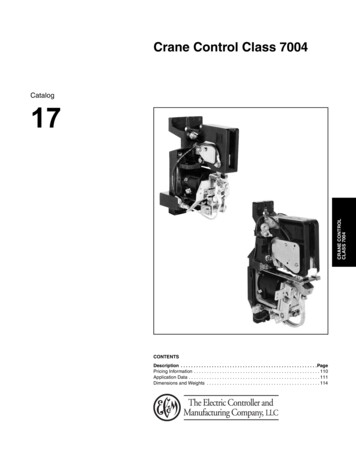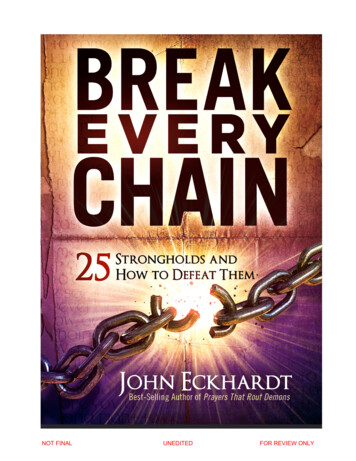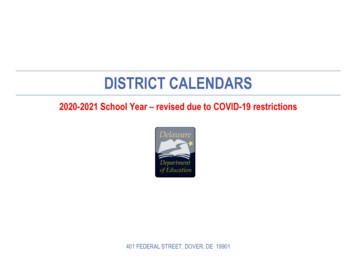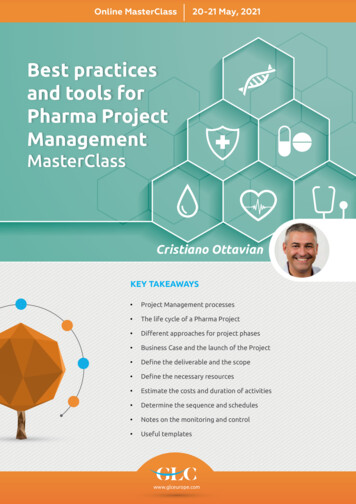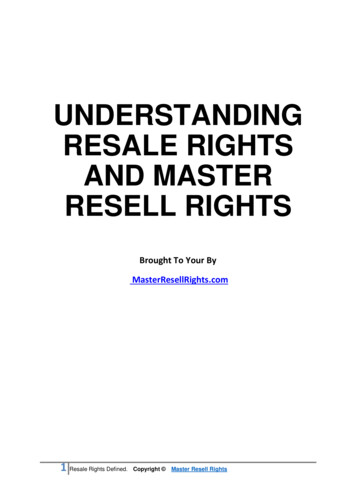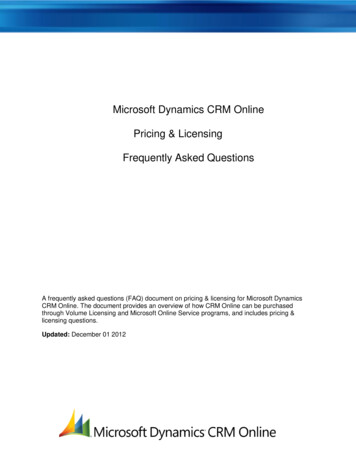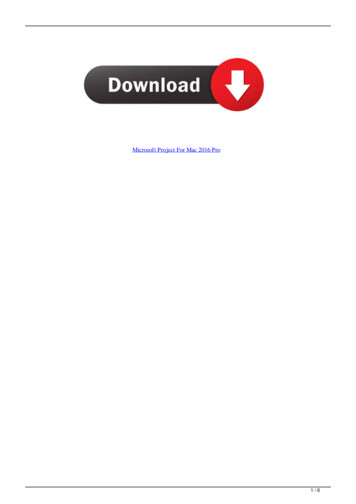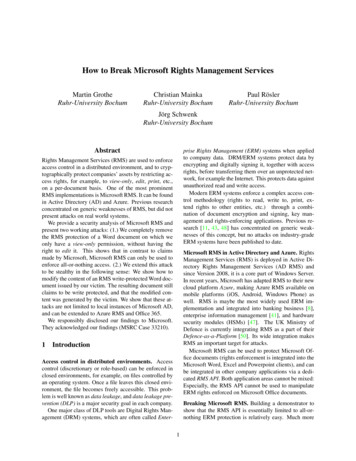
Transcription
How to Break Microsoft Rights Management ServicesMartin GrotheRuhr-University BochumChristian MainkaRuhr-University BochumPaul RöslerRuhr-University BochumJörg SchwenkRuhr-University BochumAbstractprise Rights Management (ERM) systems when appliedto company data. DRM/ERM systems protect data byencrypting and digitally signing it, together with accessrights, before transferring them over an unprotected network, for example the Internet. This protects data againstunauthorized read and write access.Modern ERM systems enforce a complex access control methodology (rights to read, write to, print, extend rights to other entities, etc.) through a combination of document encryption and signing, key management and rights-enforcing applications. Previous research [11, 43, 48] has concentrated on generic weaknesses of this concept, but no attacks on industry-gradeERM systems have been published to date.Rights Management Services (RMS) are used to enforceaccess control in a distributed environment, and to cryptographically protect companies’ assets by restricting access rights, for example, to view-only, edit, print, etc.,on a per-document basis. One of the most prominentRMS implementations is Microsoft RMS. It can be foundin Active Directory (AD) and Azure. Previous researchconcentrated on generic weaknesses of RMS, but did notpresent attacks on real world systems.We provide a security analysis of Microsoft RMS andpresent two working attacks: (1.) We completely removethe RMS protection of a Word document on which weonly have a view-only permission, without having theright to edit it. This shows that in contrast to claimsmade by Microsoft, Microsoft RMS can only be used toenforce all-or-nothing access. (2.) We extend this attackto be stealthy in the following sense: We show how tomodify the content of an RMS write-protected Word document issued by our victim. The resulting document stillclaims to be write protected, and that the modified content was generated by the victim. We show that these attacks are not limited to local instances of Microsoft AD,and can be extended to Azure RMS and Office 365.We responsibly disclosed our findings to Microsoft.They acknowledged our findings (MSRC Case 33210).1Microsoft RMS in Active Directory and Azure. RightsManagement Services (RMS) is deployed in Active Directory Rights Management Services (AD RMS) andsince Version 2008, it is a core part of Windows Server.In recent years, Microsoft has adapted RMS to their newcloud platform Azure, making Azure RMS available onmobile platforms (iOS, Android, Windows Phone) aswell. RMS is maybe the most widely used ERM implementation and integrated into banking business [8],enterprise information management [41], and hardwaresecurity modules (HSMs) [47]. The UK Ministry ofDefence is currently integrating RMS as a part of theirDefence-as-a-Platform [50]. Its wide integration makesRMS an important target for attacks.Microsoft RMS can be used to protect Microsoft Office documents (rights enforcement is integrated into theMicrosoft Word, Excel and Powerpoint clients), and canbe integrated in other company applications via a dedicated RMS API. Both application areas cannot be mixed:Especially, the RMS API cannot be used to manipulateERM rights enforced on Microsoft Office documents.IntroductionAccess control in distributed environments. Accesscontrol (discretionary or role-based) can be enforced inclosed environments, for example, on files controlled byan operating system. Once a file leaves this closed environment, the file becomes freely accessible. This problem is well known as data leakage, and data leakage prevention (DLP) is a major security goal in each company.One major class of DLP tools are Digital Rights Management (DRM) systems, which are often called Enter-Breaking Microsoft RMS. Building a demonstrator toshow that the RMS API is essentially limited to all-ornothing ERM protection is relatively easy. Much more1
challenging is the task to reverse-engineer the use of therights enforcing API by Microsoft Office applicationsand this way bypass the countermeasures implementedby Microsoft.In the paper we describe two different attacks on Microsoft Active Directory (AD) RMS for Microsoft Office. (1.) Removing the RMS protection from a protectedWord document resulting in a completely unprotecteddocument. (2.) Stealthy content modification of an RMSprotected Word document. Both attacks only require theview access right on the RMS protected file. This is theminimal right, which can be assigned to a group or usersin the Microsoft RMS environment.These attacks have a severe impact on real-world companies which rely on the RMS protection. While in principle it is always possible to leak data from a read-onlydocument by making screenshots or photos, this in practice prevents large-scale data leakage. The attacks presented in this paper make large-volume data leakage ofMicrosoft RMS protected documents feasible.Moreover, the stealthy version of our attack may enable new scenarios, for example, in spear phishing or industrial espionage. If an attacker, having only read access (e.g. an ordinary employee), may arbitrarily changethe content of a document issued by the CEO of a company, this could be used to trick other employees on performing illegal actions.Due to the efforts by Microsoft making the RMS system as much platform independent as possible, our attacks are also applicable on Microsoft’s cloud platformAzure and Office 365 [5], leading to a real extension inthe attack surface.We have implemented our attacks as a proof-ofconcept and communicated our results with Microsoft.and Azure with Office 365. We then communicatedour results with Microsoft (MSRC Case 33210).I We provide possible countermeasures. Due to thecurrent design of RMS, finding sufficient countermeasures are not trivial.2From classical DRM to modern ERMClassical access control, with its two most popularparadigms Discretionary Access Control (DAC) andRole Based Access Control (RBAC), can directly byenforced in closed systems like operating systems ordatabases. DAC is an entity-based access control concept. Access to ressources (e.g., files, directories, devices, .) is granted to single or multiple entities. InRBAC [1], access control decisions are based on roles.Each entity is assigned one or more roles. A typical example for this concept is AD from Microsoft.Digital Rights Management. In the 1990s, companieslike Microsoft and Real Networks introduced consumermarket DRM implementations to protect digital audioand video distribution. In 1998, the Digital MilleniumCopyright Act (DMCA) made it illegal to circumventDRM systems, regardless of their security. DMCA wasfirst used in a lawsuit against dozens of systems administrators in 1999 in an attempt to limit the distribution ofthe DVD decyption software deCSS.Microsoft used DRM in Windows Media Player [10]to protect multimedia files, and Real Networks implemented it in Real Player. Adobe released their own DRMsystems to protect e.g. PDF files. Most of these systems could be broken generically, by just playing and rerecording (“ripping”) the multimedia content.With DRMv2, Microsoft introduced the Windows Media Rights Manager 7 SDK, allowing to manage therights of given multimedia files (e.g., the total numberof allowed plays). DRMv2 separated the use licenses forcostumers from the protected file, previously both werestored in one file. This concept is similar to modern RMSimplementations [10].Contributions. We make the following contributions:I We describe in-depth Microsoft RMS for AD RMSand Azure RMS, including the PKI infrastructureand the used file format.I We describe and implement two novel attacks onMicrosoft RMS:(1.) removing the protection of an arbitrary file,granting full access to the attacker.Enterprise Rights Management. In June 2003 Microsoft introduced its evolved DRMv2 system namedRights Management Services as an Add-on for the Windows Server 2003 operating system. It was now namedEnterprise Rights Management to highlight that it wastargeted especially to the corporate market [38].With Windows Server 2008, RMS was fully integrated as a new server role of the Active Directoryserver [17, 28]. In 2013 Microsoft introduced ERM forits cloud platform Azure under the name Azure RMS[42]. Sometimes Information Rights Management (IRM)(2.) stealthily breaking the integrity of an RMSprotected file and allowing modifications ofthe content. The resulting file looks as if ithas been created by another person.I We implemented both attacks in a tool called Disabeling Attacks on Rights Management Services(DisARMS).1 We used DisARMS to evaluate our attacks against Microsoft AD RMS with Office 20131 https://github.com/RUB-NDS/MS-RMS-Attacks2
is used as a synonym for ERM (e.g. by EMC’s in Documentum IRM [7]).rights on the document (e.g. write, forward, print, .),without being legally entitled to get these. These advanced access rights may be acquired by interacting witha rights management server, or without such interaction.In the present paper we show how access rights can beextended without any interaction.Please note that we do not consider “ripping” attacks(e.g. taking screenshots of protected documents and forward these screenshots), as these attacks do not scalewell. We also argue that all software-based ERM systems could principally be broken by an attacker havingroot access in the OS, where the enforcement mechanismis running and the attacker have the view right on the document. Instead, we give full working implementations,running without root privileges, to extend read-only tofull access, both in direct and stealthy mode. Note, thateven with root privileges, but without view right on thedocument, the RMS protection can not be bypassed.Microsoft AD RMS. Microsoft Active Directory RightsManagement Services [13] are an on-premise ERM system by Microsoft and part of current Windows Serveroperating systems. They give employees of a companythe ability to fine-grained set rights on files they create. Windows Server is a basic system with differentenhancements, so called server roles. These roles canbe added separately. RMS is one of these server roleswhich works together with another server role, the Active Directory Domain Services (AD DS). That role isan administration tool whereby users, groups, server’s,and other objects of a companies’ infrastructure can becontrolled. The RMS then adds a special Public Key Infrastructure (PKI) to the AD DS. By this means, usersof the AD which are the employees of a company cancontrol the access to files they create.Microsoft Azure RMS. Azure RMS is part of Azure,which is a cloud platform system for storage and infrastructure sharing in- and outside of companies. Azurecombines the advantages of a cloud system with thoseof ERM and a DRM system. An Azure instance manages company users and their software and data requirements. For this Azure requires an own AD within thecloud. This AD is called Azure AD. Azure can be usedto create and work on a Virtual Machine (VM) or storedata in the cloud as well as to share those stored dataand manage the usage of documents with an integratedRMS system. During our research we analyzed Azureand Azure RMS and could successfully apply our findings from AD RMS to Azure RMS.44.1General OverviewAD RMS is an ERM solution developed by Microsoftand available since Windows Server 2003. We analyzed the implementation in the stable version of Windows Server 2012 R2. We activated the RMS featuresby enabling the server role for AD RMS in the ADDS [32]. This is an optional server role for companieswhich already use the AD DS to manage their infrastructure on-premise. The role enables employees to create protected documents with specific rights for selectedusers or groups.Microsoft further provides an RMS API. To developapplications with the API, the RMS SDK is necessary.Then applications can be created to protect generic filesvia the AD RMS or Azure RMS. In general most of theAPI functions can also be used to do legit edits on native protected Office files such as *.docx or *.pptx, buttherefore the correct rights are necessary. Also countermeasures were implemented to prevent bypasses of theRMS protection with the API functions (cf. Section 5.1).Other ERM Implementations. RMS systems were alsoimplemented by companies like Adobe or SAP. AdobeLiveCycle manages PDF documents comparable to Microsoft RMS for office documents.3Microsofts Rights Management ServicesSecurity ModelTo access an ERM protected document, which containsaccess conditions (either DAC or RBAC based), an entityneeds a license, which contains access rights bound tothis entity. The strength of this binding (and therefore thestrength of the ERM protection) depends on the enforcement mechanism, which may be either implemented partially in hardware (e.g. smart cards) or completely insoftware.Since ERM protected documents are often sent overthe Internet, our model provides the adversary with fullaccess to such documents. He also is allowed to acquirea license with limited access rights (e.g. read-only).The goal of the adversary is to get additional access4.2Test SetupFor our evaluation we installed one Windows Server andtwo Windows 7 Enterprise clients. All machines had access to a dedicated network. We then configured the twoserver roles: (1.) AD DS and (2.) AD RMS. In addition tothe server-side component, the Office Suite (Office 2013Professional) by Microsoft was required on the clients.Analysis. Before we could start testing different scenarios on our clients we had to create different users for our3
AD. We monitored the communication between clientcomputer and the AD RMS server with Wireshark. Thenwe started work flows like they would happen in a realcompany, such as domain join of a client, first login ofa user, creation of an AD RMS protected file and opening a protected document. We used a set of users for thisaction to examine the difference in the communication.We disabled TLS, to eavesdrop the traffic. Note, that disabling TLS has no impact on our attacks, they work thesame way with TLS enabled.[16]. The SLC contains the identity of the rights management server, and is used to verify user identities andto grant user’s access to protected files.A user identity consists of two certificates, the RightsAccount Certificate (RAC) and the Client Licensor Certificate (CLC), which are issued by the SLC. Both RACand CLC contain a whole key pair.2 The CLC is usedto protect files and the RAC is used to get access to protected files [19, 29]. The private key of the CLC is encrypted with the public key of the RAC. The private keyof the RAC is encrypted with the public key of the SPC.Attack. Based on the information gathered in the analysis phase, we were able to verify and extend the information extracted from Microsoft documentation and construct our attacks. Our attacks work in every networkwhich uses Microsoft AD DS or Azure AD with enabledRMS server role (AD RMS or Azure RMS). Further inevery situation Office 365 is used together with AzureRMS to protect documents. DisARMS takes a simpleERM protected document as input, with read-only rights.AD RMS Licenses. A Publishing License (PL) contains the name of the author (alice@company.com), alist with pre-configured access rights for different usersor groups (hr@company.com), and the content key [26].Examples for preconfigured access rights are view, editor print [15, 20]. Once the PL is created, it is encryptedwith the public key of the SLC. The content of the PL issigned by the author’s (Alice’s) CLC private key.The Use License (UL) contains all ERM-related information for one specific user, for example, a list withpre-configured rights for this specific user, the name ofthe author, and the content key [36]. Every data in theUL is encrypted with the public key of the RAC of theUL requesting user and signed by the servers SLC private key.Figure 1: Certificates of the AD RMS PKI.4.3The Active Directory Rights Management Services in detailAD RMS PKI. The fundamental concept of the ADRMS is a complex PKI (see Figure 1). Each certificate contains an RSA public key. This PKI consists ofcertificates and licenses. The certificates and licensesare stored in the Extensible Rights Markup Language(XrML) [37]. Certificates and Licenses are mainly structured in three parts: (1.) Issuer (2.) Key (3.) Signature[19, 26, 29, 31, 36]. Additional certificates are locatedbetween the root certificate and the Server Licensor Certificate (SLC) respectively the Security Processor Certificate (SPC), but they are not necessary to understand thisERM solution.The SPC [31] contains the identity of a computer, butit is also bound to a certain user: Its private key is encrypted with the login password of the user and the DataProtection Application Programming Interface (DPAPI)Figure 2: AD RMS protected Word-File. The encryptedcontent key is contained in the PL, which itself is encrypted with the SLC public key and signed with the private key of the author’s CLC.Protecting Documents. For the creation of a protectedOffice document (Figure 2) four steps are executed locally on the author’s machine [27]:(1.) Alice’s client software (e.g., Word) generates a random content key and uses it to encrypt the whole2 Althougha private key is in these data structures, Microsoft documentations nevertheless refer to them as certificates.4
(6.) The client software receives the UL.(7.) The private key of the user’s RAC is decrypted viathe private key of the SPC.(8.) The UL gets decrypted by the private key of theuser’s RAC.(9.) Access rights and content key get extracted and areused to(10.) Decrypt and open the document in a protectedenvironment. There the rights are enforced by deactivating options like printing or copying the content.Opening a protected document for the first time alwaysrequires a connection to the AD RMS server. After thisinitial connection the UL can be stored in the cache ofthe client. The expiration time (from 1 day to never)of caching a UL can be adjusted in the PL of the protected document or in the template used to create thedocument. [40].Figure 3: Accessing protected Word-File in AD.existing document file.(2.) Alice generates a PL, and4.4(3.) a UL for herself.The Azure RMS in detailAzure Rights Management Services is part of Azure Active Directory and enables its users to share files, for example, Office documents, with other users and preservethe control over the content and its distribution. In comparison to the classical AD RMS, Azure RMS client software is available on all modern platforms (Android, iOS,Linux, Mac OS, Windows) [18]. Therefore, protectedcontent can be consumed on mobile devices, laptops andcomputers.The work flow behind Azure RMS is similar to ADRMS, when it comes to the creation of protected documents or processing those documents. Both use the sameclient software (Office 2010-2016) to create protecteddocuments, Azure RMS also uses the same certificates(RAC, SPC, etc.) and licenses (UL and PL). Further thePKI behind Azure RMS is smaller than for AD RMS.In contrast to the AD RMS, the authentication is doneagainst an Azure AD instance and not the AD DS. Theauthentication process requires a valid Azure account. Incase the authentication procedure was finished successfully, the Azure AD server sends back a token, the clientsoftware can use to communicate with the Azure RMSinstance. The user is then able to consume or create aprotected document via the client software [21].(4.) The protected word document consists of the PL forthe server, the author’s public part of the CLC, andthe encrypted document.The protected files can then be distributed over a network share folder, via E-Mail or by copying the file to anexternal storage.Accessing Protected Documents. Once Bob wants toaccess the protected document, he uses his RAC to request a UL from the server [12]. The process is depictedin Figure 3:(1.) The client software extracts the PL and CLC of theauthor (alice@company.com) from the Word document and sends it together with the public part ofthe locally stored RAC of the requesting user to theserver.(2.) The server uses its SLC to decrypt the content keyfrom the PL.(3.) Afterwards the server extracts the access rights fromthe PL and validates whether the requesting user(bob@company.com) is allowed to access the file.(4.) In case the validation ended successfully the servergenerates a new UL for the user (with content keyand access rights) and sends it to the client software.Accessing Protected Documents. This process is shownin Figure 4. We assume that the user is already authenticated to the Azure AD and that the RAC is already storedon the client device. (1.) The client software sends thePL that is contained in the protected file, as well as the(5.) The UL is encrypted with the public key of theuser’s RAC.5
RAC, of the user, to the Azure RMS instance. (2.) AzureRMS decrypts those elements with its private key of theSLC. (3.) A list of access rights for the requesting user iscreated by the Azure RMS instance, according to the policy. (4.) The content key is extracted from the decryptedpolicy. (5.) A UL is created from the content key andthe access right list. The UL is encrypted with the RACpublic key of the requesting user. (6.) Afterwards theUL is sent to the Azure RMS client. (7.) The client software decrypts the UL with the private key of the user’sRAC. (8.) The protected document is decrypted with thesymmetric content key from the UL. (9.) The openingsoftware (e.g., Microsoft Word) gets the decrypted document with a list of rights from the RMS plugin. Thelisted rights are enforced by Word [49].has at least the view right. We therefore tried to use theRMS API in order to decrypt the encrypted content of aprotected office document. Before we could implementour first attack we encountered the first challenge.Pre-production Hierarchy. In the How-to use guide ofthe RMS SDK it is stated out, that the development of anAD RMS application should be done in a pre-productiondevelopment environment [33]. After we switched ourclient and server to this environment we were not ableto open any previously protected file anymore. Thiswas caused by the pre-production hierarchy, which replaces the original AD RMS PKI with a developmentPKI. Though, we switched back to the productive environment and started the development of DisARMS.Bypassing RMS API Countermeasures. Microsoft ADRMS implementation provides several API functions anddata structures [25], which can be used by developers toimplement their own RMS application. First it lookedstraightforward to implement an application which decrypts or encrypts an office file using the available RMSAPI functions. Examples for these functions are IpcfDecryptFile or IpcfEncryptFileStream. As a countermeasure for this method Microsoft checks whether the user,who tries to process the protected document, has theaccess right to export a document to another, potentially unprotected file format. If the user does not havethe export right, the Ipc-functions simply return NULLinstead of the decrypted/encrypted document. To bypass this restriction, we had to avoid those IpcfDecryptFile/IpcfEncryptFile functions. We therefore emulatethese functions by implementing our own, custom encrypt/decrypt functions (Appendix Listing 1 line 42 - 78)that rely on low level crypto library functions offered bythe RMS API. 3Figure 4: Accessing a protected Word file in Azure.5Attacking Microsoft RMSAs described previously attacking a DRM or an ERMsystem and removing the protection is pretty easy to accomplish, in case the attacker has control over the underlying operating system. This normally requires somekind of advanced user privileges. This is an unrealisticscenario for most employees in modern companies. Ourgoal was to show that this attack is also possible, whena user just has very limited rights on the client operatingsystem. Further we never attack the operating system,instead DisARMS exploits design flaws in AD RMS andAzure RMS. Further we extended the previous attack andenable the user, with the same client privileges as before,to modify protected content without leaving evidence ofthe modification to other users or administrators.5.1Reproduce the Office Work-Flow. To successfully execute our custom decrypt/encrypt function we had to reproduce the work-flow from Figure 4 via RMS API function calls. In total the RMS API offers 48 functions [30].So we had to find the right functions to reproduce thework-flow (as described in Section 5.2 and Section 5.3)Reverse Engineering the Correct License Structure.The IpcEncrypt/IpcDecrypt function requires a valid keyhandle to get executed. This is accomplished via thefunction IpcGetKey of the RMS API. Instead of the expected key handle, the value NULL was returned by thefunction. After eliminating all other causes of error, weanalyzed the binary structure of some licenses generatedby the RMS Sample application [23]. The encrypteddata created by the Sample application, when contentwas protected, revealed that this program stores 3 staticAttack ChallengesThe goal of our first attack is to completely remove theprotection of a given protected document, in case the user3 E.g.,we could only decrypt one block and had to implement thecipher mode manually (AES-ECB)6
bytes in front of the actual license data (Appendix Listing 1 line 4). This was never observed by the originalOffice client software. This requirement is further notdocumented by Microsoft nor described online. Afterwe prepended these bytes to our license structure we received the valid key-handle to the content key of a ournative protected document.(3.) The PL and the CLC are read and parsed, and thisinformation is used for requesting a UL via Microsoft’s RMS library, which either requests it fromthe AD RMS server or uses a previously requestedUL from the machine’s local cache.(a) If a request to the AD RMS server is used,it contains the public part of Charlie’s locallystored RAC and the PL. The server then decrypts the PL in order to determine the accessrights. In this scenario, Charlie has only theview right and the AD RMS server successfully validates that Charlie is allowed to accessthe protected document.Code Signing in Production Environments. Microsoftstates out in their How-to use guide, that productive applications need to be signed in order to get executed onclient machines [34]. Therefore the application must besigned via a Production License Agreement requestedvia Microsoft, but surprisingly this was not necessary andwe could execute DisARMS without any signing.(b) Since the previous validation step is successful, the AD RMS server uses its SLC to decrypt the content key from the PL.Finding the Correct Padding Scheme. For the secondattack we need to re-encrypt our modified data. Microsoft has two symmetric algorithms (AES-ECB andAES-CBC-4k) for content encryption [24] and offers twodifferent cryptography modes to secure the licenses andcertificates [14]. They distinguish between the protection offered by their own implementations (native) andthird party applications (generic) [35]. This results ina different selection of the content encryption algorithm.All analyzed Microsoft RMS products use the AES-ECBmode, instead of the proprietary CBC-4k mode of operation, which leads to a weaker level of security. If theCBC-4k mode of operation is used the padding is doneby the API function IpcDecrypt and IpcEncrypt automatically. For the ECB mode we needed to reverse engineerthe padding scheme. As described in Figure 2 every protected file has an encrypted content part. The first 8 bytesof this part contain the length of the content after it gotdecrypted. This way the padded bytes can be randomdata, which are ignored by the client software after it decrypts the encrypted content part.5.2(c) The server generates a new UL containing thecontent key encrypted with the public key ofCharlie’s RAC and the previously extractedaccess rights. The UL is then sent back toCharlie’s client.(d) If the UL is cached, steps (a-c) are omitted.(4.) To retrieve the private key of his RAC, Charlie hasto decrypt it with the private key of the machineSPC.4(5.) Charlie decrypts the UL by using the private keyof his RAC and extracts the content key plus theaccess rights (i.e., view).(6.) Charlie then decrypts the document by using thiscontent key and saves the plaintext of the unprotected Word document into a new file (decrypted.docx), ignoring the view right.In the end, Charlie gets the unprotected version of theoriginal file, containing all content, pictures, tables, andformatting. For a third person, there is no possibility tosee, whether this file was originally protected or not.Please note that this attack breaks the general conceptof RMS protection: an attacker can get access to thewhole file by only using the minimal access right. Although this attack seems to be straight forward (the attacker has access to the content key), there were lot ofdifficulties to obtain this attack, see Section 5.1.DisARMS Attack #1: How to RemoveRMS ProtectionThe goal of this attack is to completely remove the protection of a given protected document, in case the userhas at least the view right. DisARMS requires the RMSClients 2.1 software, as well as the C Redistributable2015 to be installed on the client computer where theview right is valid. The attack proceeds as follows (cf.Figure 5):5.3(1.) Charlie (who has view rights on the document) retrieves the protected document.DisARMS Attack #2: How to ModifyRMS Protected ContentThe previously described attack completely removes theRMS protection of a given file if the view right is granted(2.) DisARMS splits the protected document into thefollowing parts: (a) the encrypted content, (b) thePublishing License (PL), (c) and the author’s CLC.4 Thischine.7
Microsoftused DRM in Windows Media Player [10] to protect multimedia files, and Real Networks imple-mented it in Real Player. Adobe released their own DRM systems to protect e.g. PDF files. Most of these sys-tems could be broken generically, by just playing and re-recording ("ripping") the multimedia content. With DRMv2, introduced the .
